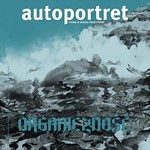To jest archiwalna strona czasopisma "Autoportret", na której zgromadzono zasoby z lat 2009-2017. Serdecznie zapraszamy do korzystania z aktualnej wersji strony i bezpośredniej lektury udostępnianych przez nas treści.
Nasze czasopismo proponuje refleksję nad kondycją przestrzeni, w jakiej funkcjonujemy. Jesteśmy przekonani o tym, że otoczenie wywiera wpływ na człowieka, a człowiek wpływa na swoje otoczenie. Przyglądanie się tej relacji pozwala nie tylko na zdobycie wiedzy o nas samych, stąd nazwa „Autoportret”, ale może się stać impulsem do zmiany na lepsze przestrzeni, w której żyjemy.
więcej o Piśmie
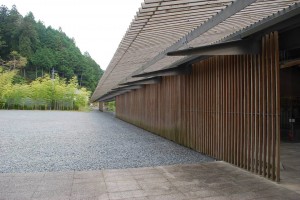
Z okazji wydania nowego numeru „Autoportretu” „materiał/materialność” zapraszamy do krakowskiego Muzeum Sztuki i Techniki Japońskiej Manggha na spotkanie poświęcone materialności w architekturze. Spotkanie rozpocznie się 15 marca o godz. 18.00. Rozmawiać będziemy o projektach Kengo Kumy i biura Ingarden & Ewý, w tym ostatnim wypadku także na podstawie materiałów Muzeum Manggha, w którym będziemy gościć.
Wykłady:
Barbara Stec – Architektoniczne dzianiny Kengo Kumy
Krzysztof Ingarden – Materialne elementy w architekturze Ingarden & Ewý
Podsumowaniem spotkania będzie dyskusja na temat materialności we współczesnej architekturze, ze szczególnym uwzględnieniem architektury japońskiej ostatnich dekad.
Prowadzenie: Dorota Leśniak-Rychlak, redaktorka naczelna „Autoportretu”
Barbara Stec -architektka, scenografka. Pracuje w Katedrze Scenografii krakowskiej ASP i na Wydziale Architektury i Sztuk Pięknych KSW. W 2000 r. obroniła na WA PK doktorat z zakresu związków architektury współczesnej ze sztuką spektaklu, przygotowywany we współpracy z IUAV w Wenecji. Autorka kilku projektów architektonicznych, scenografii teatralnych i telewizyjnych. Zajmuje się teorią i krytyką architektury współczesnej.
Krzysztof Ingarden – architekt, doc. dr inż. hab. , profesor KAAFM. Pracował w 1984–1985w biurze Arata Isozaki w Tokio, w roku 1987 w J.S. Polshek & Partners w Nowym Jorku. Współzałożyciel biura JET Atelier (1991–2009) i Ingarden & Ewý Architekci (od 1998) prowadzonego razem z Jackiem Ewým. Od roku 2003 wykłada na wydziale Architektury i Sztuk Pięknych Krakowskiej Akademii (prodziekan w latach 2003–2011). Od roku 2002 Konsul Honorowy Japonii w Krakowie. Autor wielu budynków architektonicznych, m. in. pawilonu na Expo 2005 w Japonii, Małopolskiego Ogrodu Sztuki i Centrum Kongresowego ICE w Krakowie.
Organizatorzy:
Wydawca „Autoportretu”
Malopolski Instytut Kultury
Muzeum Sztuki i Techniki Japońskiej manggha
www.autoportret.pl

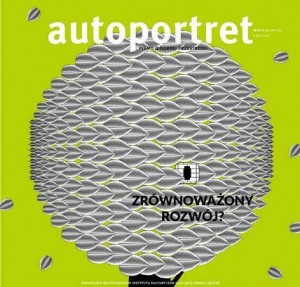
We are pleased to inform you that the English version of the current issue of the „Autoportret” quarterly is ready for download. Please find below links to the articles published in this issue:
Autoportret 3[42] 2013
Sustainability?
CENTRE, DECENTRALISATION, RECENTRALISATION Marc Augé [PDF]
NATURE AND SUSTAINABILITY IN THE ECOLOGICAL UTOPIAN TRADITION Marius de Geus [PDF]
TOWARDS THERMODYNAMIC URBAN PLANNING Philippe Rahm [PDF]
DEMOCRACY, NATURE AND UTOPIA Lucy Sargisson [PDF]
SOCRATES AND ENTHUSIASM FOR STRAW Marcin Mateusz Kołakowski [PDF]
CARBON NEUTRAL CITIES? Ida Kiss [PDF]
NATURAL MATERIALS: HISTORY OR HOPE? Dalibor Hlaváček [PDF]
RIGHT-ABOUT MODERNISM? Dawid Krysiński [PDF]
THE RECYCLED CITY Levente Polyák [PDF]
GREEN ARCHITECTURE Jana Tichá [PDF]
HOUSE UNDER THE APPLE TREE IN MARIANKA Ivan Jarina [PDF]
UNSUSTAINABLE UNDEVELOPMENT Damas Gruska [PDF]
THE FUTURE OF THE MESSAGE Mateusz Curyło [PDF]
END.LESS Rossano Baronciani [PDF]
The issue has been published with the financial support of the International Visegrad Fund.

In the current issue we draw a link between a topic (death) and an area (Central Europe). Neither the topic nor the area have infrequently been discussed recently but we feel that in combining them we may reveal the potential of the non-obvious that is inherent in both.
We invite you to read!
In the issue:
Titania hidden behind a fan by Emiliano Ranocchi
Vienna – the Worldly Capital of Death by Wittigo Keller
Common Hygiene by Miroslav Petříček
Concise Typology of Gothic Death by Dušan Buran
Paintings of the Dead in the Art of Modern Europe Beyond the Alps by Piotr Krasny
Ars Moriend in Upper Hungary by Katarína Chmelinová
Where Death is Not Bad by Vladimír Czumalo
Life for your country! But for which one? by Mátuš Dulla
Against Illness – Against Death by Aleksandra Paradowska
Jewish Way of Dying by Przemysław Piekarski
Blood on the Plate by Aleš Roleček
A not-so-merry graveyard by Łukasz Galusek
Heroes and Kopjafas in Hungary During The Shift of Regime by Nóra Kovács
To Survive a Year as a Celery. Joanna Nowostawska-Gyalókay talks to Krzysztof Varga
The Curse of Time by Agnieszka Szeffel
As Not to Frighten the Soul. Magdalena Petryna talks to Małgorzata Szumowska
Own Death by Péter Nádas
Financial support for ‘Death in Central Europe’ issue:
International Visegrad Fund www.visegradfund.org


Wojciech Wilczyk, Amager – Englandsvej, 2014, z cyklu Blue Pueblo, fotografia,
50 × 50 cm
Polecamy wystawę Wojciecha Wilczyka i Grzegorza Wróblewskiego, stanowiąca prezentację ich wspólnego projektu “Blue Pueblo”. Na wystawie poezja i fotografia wzajemnie się przenikają. W 2013 roku powstał poemat Grzegorza Wróblewskiego Blue Pueblo. Zainspirowany tym utworem fotograf Wojciech Wilczyk wykonał zdjęcia ukazujące architekturę Amager, dzielnicy Kopenhagi, w której mieszka poeta. Ulice Amager stają się w utworze Wróblewskiego niemym świadkiem ludzkiego dramatu. Poemat jest zapisem przeżyć człowieka, który za pomocą silnych środków odurzających próbuje stłumić cierpienie związane z rozstaniem z ukochaną osobą. Psychologa ani religia nie przynoszą ukojenia. Samotność przeradza się w fizyczne cierpienie. Opisy biologiczności człowieka przeplatają się z odniesieniami do świata literatury, sztuki i muzyki; to, co zmysłowe, miesza się z tym, co duchowe. W końcu jedynym sposobem wyzwolenia okazuje się natura: „Jechać w stronę lasu i rzeki. Szukać tam ludzi. Szukać gwiazdy. Dopóki nie nastąpi definitywna podróż”.
Fotografie są wyrazem przeżyć zawartych w poemacie. Czarno-białe zdjęcia wyludnionej metropolii ukazują obojętność miasta wobec cierpiącej jednostki, ale także stanowią wizualizację stanu ducha, przejmującej pustki po stracie kogoś bliskiego. Symetryczne kadry, powtarzalne motywy architektoniczne, gra cieni na fasadach sprawiają, że świat ukazany na fotografiach wydaje się nieprzyjazny człowiekowi, obcy. Napis „death” na jednym z budynków potęguje wrażenie zagrożenia, balansowania na granicy życia i śmierci.
(materiały prasowe MOCAK)
Wojciech Wilczyk, Grzegorz Wróblewski
Poezja i fotografia – projekt „Blue Pueblo”
Wernisaż: 15.10.2015
Czas trwania wystawy: 16.10.2015–17.1.2016
Kurator: Agnieszka Sachar
Miejsce: Galeria Alfa, MOCAK – Muzeum Sztuki Współczesnej w Krakowie
‘Autoportret’ jest patronem medialnym wydarzenia
We are pleased to inform you that the English version of the current issue of the „Autoportret” quarterly is ready for download. In this issue we are asking about sustainability. Ruthlessly exploited, the concept of ‘sustainable development’ is an empty platitude in view of growing global instability. Can all pro-ecological ideas and attempts to implement them, which we present in this issue of ‘Autoportret’ be significantly effective against rigid dogmas of the model of development based on the calls for progress and growth?
The issue has been published with the financial support of the International Visegrad Fund.

We are pleased to inform you that the English version of the current issue of the „Autoportret” quarterly is ready for download.
Full English version of our website is still under construction and will be launched soon.
Autoportret 1[36]/2012
Identity after ’89
Emiliano Ranocchi, From a vantage [PDF]
Ewa Rewers, Marginalisation of the interpretative power of context [PDF]
Contemporary Silesian architecture – discussion between Andrzej Duda, Leszek Jodliński, Dorota Leśniak-Rychlak, Tomasz Nawrocki, Anna Syska [PDF]
Elżbieta Rybicka, Global and local [PDF]
Karol Kurnicki, Ideology and power in a post-socialist city [PDF]
Anna Rumińska, The townie vs. the city dweller [PDF]
Vladimir Czumalo, Architecture and identity [PDF]
Jana Tichá, The stone Modernism and visual weakness of digital age [PDF]
Damas Gruska, In search of Slovakia [PDF]
Samu Szemerey, Identities of a housing estate [PDF]
Valentina Gulin Zrnić, The mammoth-building story [PDF]
Levente Polyak, Exchange in the street [PDF]
Jens R. Fischer, Identity at a turning point [PDF]
Matej Jaššo, The city as a personality [PDF]
Peter Michalík, Our (post-) socialist cities [PDF]
Łukasz Białkowski, The future shall set us free? [PDF]
Jurko Prochaśko, How is a Middle European possible and what is his benefit today? [PDF]
 The issue has been published with the financial support of the International Visegrad Fund.
The issue has been published with the financial support of the International Visegrad Fund.
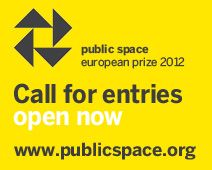
Poniżej przedstawiamy informacje dotyczące naboru zgłoszeń do kolejnej edycji nagrody European Prize for Urban Public Space 2012.
***
WHY PUBLIC SPACE?
With ideas of equality, plurality and progress constituting part of its very foundations, the European city is today facing new challenges arising from its exponential growth and increasing social and cultural complexity. Some of society’s main problems are radically expressed in the city’s public spaces. Segregation, rampant construction, homogenisation and privatisation of urban space are some of the phenomena that are putting into jeopardy the ideal of the open, plural and democratic community that has always been so distinctive of the European city.
The European Prize for Urban Public Space is a biennial competition that aims to recognise and encourage the creation, recovery and improvement of public space in the understanding that the state of public space is a clear indicator of the civic and collective health of our cities.
CALL FOR ENTRIES
The sponsoring institutions of the Seventh European Prize for Urban Public Space are the following:
– Barcelona: Centre de Cultura Contemporània de Barcelona (Centre of Contemporary Culture of Barcelona – CCCB)
– Frankfurt: Deutsches Architekturmuseum (DAM)
– Helsinki: Museum of Finnish Architecture (MFA)
– London: The Architecture Foundation (AF)
– Paris: La Cité de l’Architecture et du Patrimoine
– Rotterdam: Nederlands Architectuurinstituut (NAI)
– Vienna: Architekturzentrum Wien (Az W)
The Prize, which is honorific by nature, is awarded jointly to the authors and promoters of the projects chosen by the Jury. The prize-winners (of the Prize itself and Honourable Mentions) will receive a Diploma confirming the award. In addition, the winner of the Prize will receive a commemorative plaque which is to be installed in the prize-winning public space.
The prize-winning works, the finalists and a selection made by the Jury will be published in the European Archive of Urban Public Space, which brings together and makes available to the public the best projects that have been presented in the competition since its inception.
INTERNATIONAL JURY
The Jury of the 2012 Prize will consist of the following members:
President: Josep Llinàs, who will be representing the Centre of Contemporary Culture of Barcelona
Jury members:
Ole Bouman, director of the Nederlands Architectuurinstituut (NAI)
Sarah Ichioka, director of The Architecture Foundation (AF)
Juulia Kauste, director of the Museum of Finnish Architecture (MFA)
Francis Rambert, director of La Cité de l’Architecture et du Patrimoine
Peter Schmal, director of the Deutsches Architekturmuseum
Dietmar Steiner, director of the Architekturzentrum Wien (Az W)
Secretary: David Bravo i Bordas, representing the Centre of Contemporary Culture of Barcelona
The Jury will take into consideration only those interventions that comply with the conditions of participation and it is empowered to declare the competition null and void. Secretariat functions will be performed by the Centre of Contemporary Culture of Barcelona, which will designate the secretary who is to assist the jury and produce the minutes of the sessions during the selection process of the Prize winners.
SCHEDULE
– 17 October 2011 – opening of the campaign of calling for entries for the Prize
– 17 October 2011 – 19 January 2012 – period of registration
– 5 March – 11 April 2012 – first part of the Jury’s deliberations (on-line)
– 19 and 20 April 2012 – Jury’s working sessions at the CCCB
– 29 June 2012 – prize-giving ceremony
CONDITIONS OF PARTICIPATION
Works that have created, recovered or improved public space within the geographic limits of the Council of Europe in the years 2010 and 2011 may present for the Prize. These entries must be presented by the authors or the institutions that have sponsored the public space project.
Given that some urban public space interventions are of very long duration, any project that has not been completely finalised in the time period of 2010-2011 may still present for the Prize if enough phases of the envisaged end result have been completed to enable evaluation of the eventual repercussions of the intervention as a whole within its urban setting.
Anyone wishing to present for the Prize must complete and submit, within the established time limit, all the documentation stipulated in the Rules.
SELECTION CRITERIA
The criteria that will govern selection of the prize-winning projects from among those that are presented for the European Prize for Urban Public Space will not only be related with the quality of the work from a strictly architectural point of view since the jury will also consider other aspects in its evaluation of the effects of the urban transformation that has taken place in the specific setting and its impact on collective life:
– The explicitly urban nature of the intervention. The size of the city or town is not a limiting factor although priority will be given to medium-sized or large municipalities and those with a more general urban significance.
– The public ownership and/or clearly public-spirited vocation of the project.
– Appropriateness of interventions to the functions required of public space, from those directly linked with citizens’ occupation of a space, through to those pertaining to the collective imaginary.
– Capacity of the interventions to reduce social fractures within the city and eliminate physical and/or symbolic barriers in order to enhance quality of life for the inhabitants.
– Contribution of the projects in the domain of environmental improvement, in promoting public transport and innovation in the treatment of public installations, energy resources and urban waste.
– The degree of citizen participation and engagement in the conception, production and/or subsequent maintenance of the space. Degree of acceptance of the project by users.
– Transversal character of the planning concepts and/or objectives that have guided the project (sociology, demography, history, architecture, economy, engineering, landscaping, anthropology).
DOCUMENTATION REQUIRED
The documentation required from anyone who wishes to present for the Prize is:
– 3 rigid panels in DIN A3 format with graphic and textual information about the work.
– A description of the work, approximately 4,500 characters in length, written in English and including an account of the previous state of the site, the aim of the intervention, a description of the intervention, and a final assessment of the project.
– A minimum of 10 photographs and plans of the work.
ENTRY PROCEDURE
The entry procedure for the Prize, which is free of charge, consists of two parts:
On-line registration
To begin your registration click on the REGISTRATION button on the upper left part of this page.
The participant must register on-line by filling in, first, the basic form regarding the project and contact person and, then, providing all the other necessary information (technical file for the project, 3 panels, descriptive account, information concerning author/s, promoter/s, and photographs), besides uploading the photos and plans of the work.
The person entering for the Prize can continue to modify and complete the registration file as often as s/he wishes until the registration period closes. On-line registration automatically closes on 19 January 2012.
If the person entering for the Prize is presenting more than one work, the on-line registration procedure must be followed for each work separately.
Detailed instructions regarding on-line registration may be found at
http://www.publicspace.org/files/GUIDELINES.pdf
Presentation of the physical material at the CCCB
The following documentation must be submitted to the CCCB:
. One printed and signed copy of the Rights Sheet (this may be found in the procedure for on-line registration) once the data have been duly provided.
. 3 numbered panels: these must be rigid (in foam board or similar material) in DIN A3 format and oblong orientation. They must contain the following information:
– Map (or photomap) showing the location of the work inside its urban context (to scale).
– A pair of photographs of the site before and after the intervention, preferably from the same vantage point.
– Photographs of the finished work, indicating the two that are considered to be most representative. Images showing citizen use of the new space will be positively valued.
– Textual explanations in English where deemed necessary.
The documentation must be submitted in a well protected packet through the post, delivered by messenger or in person at the CCCB before 23 January at 2 p.m. In the case of packages sent by post or messenger, the date of dispatch must be certified at the post office or by the messenger service, and the CCCB is to be notified of the dispatch of the package at publicspace@publicspace.org on the same day. The package should be sent to the CCCB general registry (open on non-holidays from Monday to Friday, from 9 a.m. to 2 p.m.), at the following address:
PUBLICSPACE 2012 / registration code
Registre General
Centre de Cultura Contemporània de Barcelona
Montalegre, 5
E-08001 Barcelona
Espanya
The documents submitted for the Prize will not be returned to the participants, who will not receive any fees for rights of public communication or use of the material selected, and who will also bear the costs of any claim or outlay pertaining to rights of intellectual property that might arise from the reproduction or use by the organisers of the projects that are presented. Entering for the Prize requires conformity with all the conditions specified in these rules.
INFORMATION
INFORMATION, CONTACT AND RECEPTION OF DOCUMENTATION
Centre de Cultura Contemporània de Barcelona
Montalegre, 5
E-08001 Barcelona
Tel.: +34.93.306.41.00
www.publicspace.org
publicspace@publicspace.org
We are pleased to inform you that we have prepared an English version of the “Utopias” issue of “Autoportret”, which has been distributed in a form of a limited CD edition during the European Culture Congress in Wrocław.
Please find below all articles in separate PDFs.

AUTOPORTRET
2[34]/2011 UTOPIAS
Dorota Jędruch, Editorial [PDF]
Crisis of utopia? Editorial questionnaire [PDF]
Dorota Jędruch, The trouble with utopia [PDF]
Jarosław Urbański, Beyond the horizon [PDF]
Paweł Jaworski, This is how gradually a calm, intelligent and valuable industrial worker is created… [PDF]
Łukasz Stanek, Collective luxury [PDF]
Terra – Michał Duda and Roman Rutkowski talk to Stefan Müller [PDF]
David Crowley, Cold war landscapes [PDF]
Michał Wiśniewski, Concrete garden [PDF]
Piotr Winskowski, A lopsided space-time loop [PDF]
Tomasz Z. Majkowski, A utopia that will come [PDF]
Emiliano Ranocchi, From machine to man & back again [PDF]
Simona Forti, Politically corrected bodies [PDF]
Notes on the authors [PDF]
Quotation [PDF]
 The English edition has been prepared with the financial support of the ‘Victoria’ Coking Plants PLC (WZK „Victoria” S.A.) in Wałbrzych.
The English edition has been prepared with the financial support of the ‘Victoria’ Coking Plants PLC (WZK „Victoria” S.A.) in Wałbrzych.
Z przyjemnością informujemy, że “Autoportret” objął patronatem IV edycję konkursu odbywającego się w ramach projektu Galeria Zewnętrzna Miasta Gdańska.
Inicjatorem działającej od 2004 roku Galerii jest Centrum Sztuki Współczesnej Łaźnia. Projekt ma stanowić bodziec do zmiany charakteru dzielnicy Dolne Miasto, w której instytucja jest zlokalizowana. Organizatorzy chcą włączyć się w proces transformacji społecznej i architektonicznej zaniedbanej dzielnicy poprzez współdziałanie w zakresie wieloletniego planu rewitalizacyjnego. Powołany przez Prezydenta Miasta Gdańska Komitet Organizacyjny wraz z koordynatorami i kuratorami, raz na dwa lata dokonuje wyboru miejsca, a następnie w ramach zamkniętego konkursu, dokonuje wyboru projektów przeznaczonych do realizacji w przestrzeni dzielnicy.
Dotychczas miały miejsce trzy edycje konkursu. Zrealizowano 3 nagrodzone projekty (Invisible Gate wg projektu grupy Front Studio, Staging Anonymous autorstwa Dominika Lejmana oraz Undercover autorstwa Esther Stocker), kolejne 3 są w trakcie realizacji (Amber Drops autorstwa Daniela Schlaepfera i Freda Hatta, Scent of Colour autorstwa Carmen Einfinger oraz Leader Swing autorstwa Fernando Sancheza Castillo).
W IV, tegorocznej, edycji Konkursu przestrzenią przeznaczoną do realizacji projektu jest skrzyżowanie ulic Kamienna Grobla, Dobra i Toruńska w Gdańsku (włączając obszar mostu, betonowe bulwary nadrzeczne i przystanek autobusowy). Przy tworzeniu projektów artyści wezmą pod uwagę historyczny charakter ulic oraz usytuowanie przestrzeni w punkcie przecięcia tras pieszych prowadzących z miejsc realizacji zwycięskich obiektów I, II i III edycji Konkursu oraz z Centrum Sztuki Współczesnej Łaźnia na średniowieczne fortyfikacje położone na granicy Dolnego Miasta.
W 2011 roku do konkursu zaproszeni zostali: Bert Theis (Luxemburg), Tea Makipaa (Finlandia), Weronika Kiersztejn & Michał Kozik (Polska), Alexandre Arrechea (Kuba), Olaf Nicolai (Niemcy), Marcus Miessen (Niemcy), Sabina Lang & Daniel Baumann (Szwajcaria) oraz Thorsten Goldberg (Niemcy), którzy do 30 czerwca przygotują projekty na zagospodarowanie przestrzeni objętej IV edycją konkursu.
Wyboru trzech zwycięskich projektów dokona 9 lipca 2011 międzynarodowe Jury konkursu w składzie:
Adam Budak, kurator, Museum-Joanneum, Graz, Austria
Jadwiga Charzyńska, kuratorka, dyrektor Centrum Sztuki Współczesnej ŁAŹNIA, Gdańsk, Polska
Jacek Dominiczak, architekt, teoretyk, edukator, Akademia Sztuk Pięknych w Gdańsku, Polska
Julia Draganovic, historyczka i krytyczka sztuki, niezależna kuratorka, Modena, Włochy
Enrico Lunghi, kurator, dyrektor Mudam Luxembourg, Musée d’Art Moderne Grand-Duc Jean, Luxemburg, Luxemburg
Bettina Steinbrügge, kuratorka, Belvedere, Vienna, Austria, kuratorka Forum Expanded Berlinale, Berlin, Niemcy
Norbert Weber, kurator, ekspert, wykładowca, członek międzynarodowej rady ekspertów Muzeum Sztuki Współczesnej Łotwy w Rydze, Łotwa
11 lipca 2011 r. na konferencji prasowej zostanie ogłoszony laureat konkursu, natomiast we wrześniu w CSW Łaźnia zostanie pokazana wystawa pokonkursowa.
[Na podstawie materiałów nadesłanych przez Organizatorów]
We are pleased to inform you that the English version of the current issue of the “Autoportret” quarterly is ready for download.
Full English version of our website is under construction and will be launched soon.
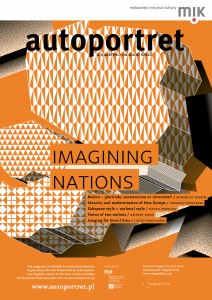
Autoportret 3[32]/2010
Imagining Nations
Miroslav Hroch The modern nation: a platitude, construction or invention? [PDF]
Jan Randák Where is my home? [PDF]
Andrzej Szczerski New Europe [PDF]
Dušan Škvarna Genuine or artificial homeland [PDF]
Anna Vetraková An appealing symbol of Slovakia [PDF]
Antoni Kroh The Tatras of nations [PDF]
David Crowley Zakopane style − national style [PDF]
Jakub Puchalski The nationality of music? [PDF]
Aleksandra Paradowska In the suburbs but close to the centre [PDF]
András Hadik ‘There was no Hungarian language of forms but there will be’ [PDF]
Noémi Petneki A steppe nomad or stray rider? [PDF]
Endre Prakfalvi, Pál Ritoók Socialist in content, national in form [PDF]
Jurko Prochaśko Sense and sensation [PDF]
Vadim Bass Takeaway literature [PDF]
 The issue has been published with the financial support of the International Visegrad Fund.
The issue has been published with the financial support of the International Visegrad Fund.

